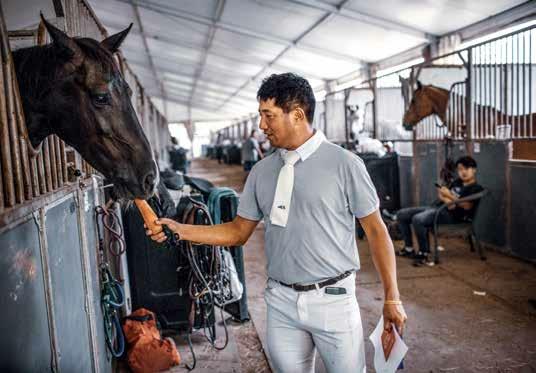Riders from the Plateau
2020-09-30byQinBin
by Qin Bin

As early as 5:30 on summer mornings, punctual hoof beats could already be heard in Dongfu Village. They marked the start of the day for the Tibet Equestrian Team. Dongfu Village is in Beixiaoying Town of Beijings Shunyi District, about 50 kilometers away from downtown. Few know that this village, which features well-preserved northern Chinese traditional structures, is the training base for the Tibet Equestrian Team.
The Tibet Equestrian Team was established in 1986. Current coach Tenzin and captain Tsodong were among the teams first athletes. When the team was established, the Inner Mongolia Autonomous Region was the strongest place in the country for horsemanship. So, 40 athletes from the team went to Hohhot, the capital of the autonomous region, for a year-long intensive training program. Because of inconvenient transportation links between Tibet and other parts of the country at the time and soaring costs of shipping racehorses back to Tibet, in 1992, the Administration of Sport of the Tibet Autonomous Region decided to relocate the equestrian team to Beijing. Since moving to Beijing, the team used multiple locations before finally settling in Dongfu Village in 2016. Its members have built their own stables, removed weeds, renovated horseracing tracks, and used imported European steeds instead of domestically bred species and thoroughbreds.
The team now features six athletes and one apprentice, who are all Tibetan. It also offers training courses for numerous talented youngsters. The teams major activities include participating in international contests hosted by the International Equestrian Federation and preparing for the Tokyo Olympics and the 2021 National Games of China. All equestrian sports feature both individual and team events in three categories: show jumping, eventing, and dressage. The Tibet Equestrian Team is currently focused on show jumping and eventing, and is just starting to engage on dressage competitions.
Equestrian sports are very expensive. European warmbloods are a must for professional competitions, and they are exceptionally costly. Each warmblood horse costs as much as one million yuan (US$145,000), which doesnt include horse keeping and medical care. Even thoroughbreds, which dont perform as well as warmbloods, cost a lot to purchase and keep. The huge cost is certainly a barrier for equestrian enthusiasts. The financial problems hindering the Tibetan Equestrian Team mirror many of the problems holding back development of equestrian sports in China. The appalling costs have driven many Chinese to consider equestrian sports to be for nobility or reserved for aristocratic types. Many horse lovers in the country have been turned off by the sport.

Since its establishment, the Tibet Equestrian Team has endured many difficulties such as financial troubles and a lack of qualified horses. But their good performance at competitions earned them full support from the Administration of Sport of the Tibet Autonomous Region. Its financial support enabled the team to travel to Europe for surveys and studies in 2012. The team purchased French warmbloods and hired four French coaches to train athletes and horses. The trip to Europe opened their eyes and expanded their minds. The team eagerly embraced advanced equestrian concepts. They eliminated previous outdated practices of pushing horses through unreasonable and hard training in favor of a more scientific approach. Before the COVID-19 pandemic, the team visited France semi-annually for a three-month training session. Europes advanced equestrian culture, pleasant environment, and frequent competitions helped the team grow at breakneck speed. Eventually, the teams members Penpa Tsering and Kelsang Phuntsok made their way into the Chinese equestrian team and qualified for the Tokyo Olympics.